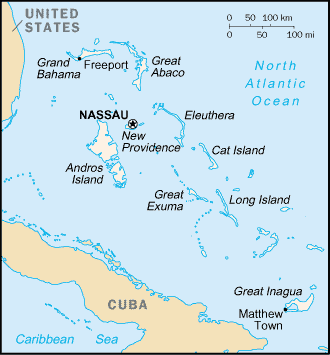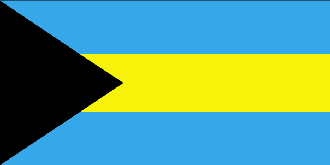
|
The Bahamas
Background:
Arawak Indians inhabited the islands when Christopher Columbus first set foot
in the New World on San Salvador in 1492. British settlement of the islands
began in 1647; the islands became a colony in 1783. Since attaining
independence from the UK in 1973, The Bahamas have prospered through tourism
and international banking and investment management. Because of its geography,
the country is a major transshipment point for illegal drugs, particularly
shipments to the US, and its territory is used for smuggling illegal migrants
into the US.
Location:
Location: Caribbean, chain of islands in the North Atlantic Ocean, southeast of
Florida, northeast of Cuba.
Area: Total: 13,940 sq km, water: 3,870 sq km, land: 10,070 sq km.
Area - comparative: Slightly smaller than Connecticut.
Coastline: 3,542 km.
Climate and Terrain:
Climate: Tropical marine; moderated by warm waters of Gulf Stream.
Terrain: Long, flat coral formations with some low rounded hills.
Elevation extremes: Lowest point: Atlantic Ocean 0 m, highest point: Mount
Alvernia, on Cat Island 63 m.
Natural resources: Salt, aragonite, timber, arable land.
Land use: Arable land: 0.6%.
Environment - current issues: Coral reef decay; solid waste disposal.
People:
Population: 297,477.
Ethnic groups: Black 85%, white 12%, Asian and Hispanic 3%.
Religions: Baptist 32%, Anglican 20%, Roman Catholic 19%, Methodist 6%, Church
of God 6%, other Protestant 12%, none or unknown 3%, other 2%.
Languages: English, Creole.
Government:
Government type: Constitutional parliamentary democracy.
Capital: Nassau.
Independence: 10 July 1973 (from UK).
Economy overview:
The Bahamas is a stable, developing nation with an economy heavily dependent
on tourism and offshore banking. Tourism alone accounts for more than 60% of
GDP and directly or indirectly employs half of the archipelago's labor force.
Steady growth in tourism receipts and a boom in construction of new hotels,
resorts, and residences had led to solid GDP growth in recent years, but the
slowdown in the US economy and the attacks of 11 September 2001 held back
growth in these sectors in 2002. Manufacturing and agriculture together
contribute approximately a tenth of GDP and show little growth, despite
government incentives aimed at those sectors.
GDP - composition by sector: Agriculture: 3%, industry: 7%, services: 90%.
Industries: Tourism, banking, e-commerce, cement, oil refining and
transshipment, salt, rum, aragonite, pharmaceuticals, spiral-welded steel pipe.
Statistics:
Telephones - main lines in use: 96,000.
Telephones - mobile cellular: 6,152.
Radio broadcast stations: AM 3, FM 4.
Radios: 215,000.
Television broadcast stations: 1.
Televisions: 67,000.
Internet users: 16,900.
Railways: 0 km
Highways: Total: 2,693 km, paved: 1,546 km, unpaved: 1,147 km.
Airports: 64,
with paved runways: Total: 30,
with unpaved runways: Total: 34.
Heliports: 1.
Return to Visiting Locations
|

